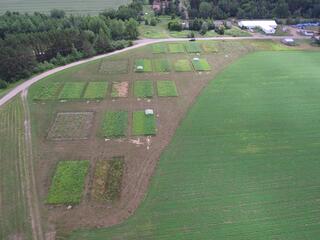No single bioenergy crop best suited for marginal lands

A marginal lands crop system experiment in Rhinelander, Wis., seen in July 2020 as growth approached peak biomass.
Background
Growing lignocellulosic crops on marginal farmlands offer a promising way to support biofuel production while minimizing conflict with food production. Here researchers compared the productivity of six bioenergy cropping systems across different climate and soil conditions.
Approach
Scientists with the Great Lakes Bioenergy Research Center evaluated switchgrass, miscanthus, hybrid poplar, native grasses, early succession vegetation, and restored prairie – with and without fertilization – at each of five sites in Michigan and Wisconsin using historical vegetation as a control. Biomass yields were measured for the first seven years after establishment.
Results
Yields varied substantially by crop and site. Miscanthus was most productive at three of five sites, but switchgrass was the most consistently productive across all sites. Yields of miscanthus and switchgrass peaked after 4-5 seasons and declined thereafter, while native grasses and restored prairie gradually increased with no sign of decline. Nitrogen fertilization significantly increased yields of all systems at all sites.
Impact
Results demonstrate the viability of low-productivity former cropland for long-term bioenergy production and suggest there is no single crop best suited for all such soils. Yield trends suggest polyculture may outperform monocultures over the long term.
Jayawardena, Dileepa M., Robertson, G. Philip, Sanford, Gregg R., & Thelen, Kurt D. Comparative productivity of six bioenergy cropping systems on marginal lands in the Great Lakes Region, United States. Agronomy Journal, 115, 2451–2468. (2023) [DOI:10.1002/agj2.21416]